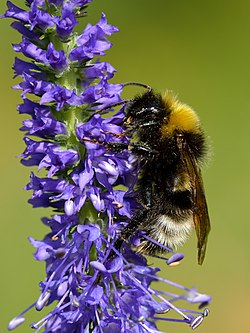This article needs additional citations for verification .(June 2010) |
















Honeybees often collect nectar, pollen, or both from the following species of plants, which are called honey plants, for making honey. This is not an exhaustive list of the flowering plant species Honeybees will visit.
Contents
- Acanthaceae (Acanthus family)
- Aceraceae (Sapindaceae) (Maple family)
- Agavaceae (Agave family)
- Alstroemeriaceae
- Amaranthaceae (Amaranth family)
- Amaryllidaceae (Amaryllis family)
- Anacardiaceae (Cashew family)
- Apiaceae (Parsley and carrot family)
- Apocynaceae (Dogbane family)
- Aquifoliaceae (Holly family)
- Araliaceae (Aralia and ivy family)
- Asclepiadaceae (Milkweed family)
- Arecaceae (Palm family)
- Asteraceae (Aster, daisy, sunflower family)
- Bignoniaceae (Trumpet creeper family)
- Bixaceae (Achiote family)
- Bombacaceae (see also Malva family)
- Boraginaceae (Borage or Forget-me-not family)
- Brassicaceae (Mustard family or cabbage family)
- Caesalpinioideae
- Cannabaceae (Hemp Family)
- Capparaceae (Caper family)
- Caprifoliaceae (Honeysuckle family)
- Caryocaraceae
- Caryophyllaceae (Carnation family)
- Celastraceae (staff vine or bittersweet family)
- Chrysobalanaceae
- Clethraceae
- Clusiaceae
- Cochlospermaceae
- Combretaceae
- Commelinaceae
- Convolvulaceae (Bindweed or morning glory family)
- Cucurbitaceae (Melon, cucumber, calabash, squash family)
- Cunoniaceae
- Dilleniaceae
- Ebenaceae
- Elaeocarpaceae
- Ericaceae (Blueberry, Heather family)
- Erythroxylaceae (Coca family)
- Escalloniaceae
- Euphorbiaceae (Spurge family)
- Faboideae (Legume family)
- Hamamelidaceae
- Iridaceae
- Lamiaceae (Mint family)
- Lauraceae (Laurel family)
- Lecythidaceae
- Liliaceae (Lily family)
- Lythraceae
- Magnoliaceae (Magnolia and tulip tree family)
- Malpighiaceae
- Malvaceae (Malva family)
- Meliaceae (Mahogany family)
- Mimosoideae
- Myrsinaceae
- Myrtaceae (Myrtle family)
- Ochnaceae
- Oleaceae (Olive family)
- Oxalidaceae
- Polygonaceae
- Passifloraceae (Passion flower family)
- Poaceae(Gramineae)
- Proteaceae
- Rhamnaceae (Buckthorn family)
- Rosaceae (Rose family)
- Rubiaceae (Madder, bedstraw, coffee family)
- Rutaceae
- Salicaceae (Willow and poplar family)
- Sapindaceae (Soapberry family)
- Scrophulariaceae
- Solanaceae (Tomato, potato, egg plant family)
- Styracaceae
- Sterculiaceae
- Tamaricaceae
- Tiliaceae (Basswood, linden family)
- Urticaceae (Nettle family)
- Verbenaceae (Verbena family)
- Vochysiaceae
- See also
- References
- External links















